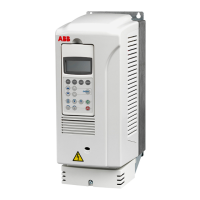Start-up and use 31
Note: The drive/inverter indications are described in more detail in section STO status
indications on page 13.
Use
1. Open the activation switch, or activate the safety functionality that is wired to the STO
connection.
2. STO inputs on the ASTO board de-energize, and the ASTO board cuts off the control
voltage from the drive/inverter IGBTs.
3. The control program generates an indication as defined in section STO status
indications on page 13.
4. The motor coasts to a stop (if running). The drive/inverter cannot restart while the
activation switch or safety relay contacts are open. After the contacts close, a new
start command may be required to start the drive (depends on parameter settings).
5. Deactivate the STO by closing the activation switch, or resetting the safety
functionality that is wired to the STO connection.
6. Reset any faults before restarting.
WARNING! The Safe torque off functionality is only achieved, when the ASTO
board is installed on the inverter module. True Safe torque off functionality is not
achieved, if the option board is installed on other types of modules, such as the
supply unit or the brake unit.
WARNING! (With permanent magnet motors only) In case of a multiple IGBT
power semiconductor failure, the inverter system can produce an alignment
torque which maximally rotates the motor shaft by 180/p degrees regardless of
the activation of the Safe torque off function. p denotes the number of pole pairs.
Notes:
• If a running drive/inverter is stopped by using the Safe torque off function, the drive/
inverter will cut off the motor supply voltage and the motor will coast to a stop. If this
causes danger or is not otherwise acceptable, stop the drive/inverter and machinery
using the appropriate stop mode before activating the Safe torque off function.
• The Safe torque off function overrides all other functions of the drive/inverter.
• The Safe torque off function is ineffective against deliberate sabotage or misuse.
• The Safe torque off function has been designed to reduce the recognized hazardous
conditions. In spite of this, it is not always possible to eliminate all potential hazards.
The assembler of the machine must inform the final user about the residual risks.

